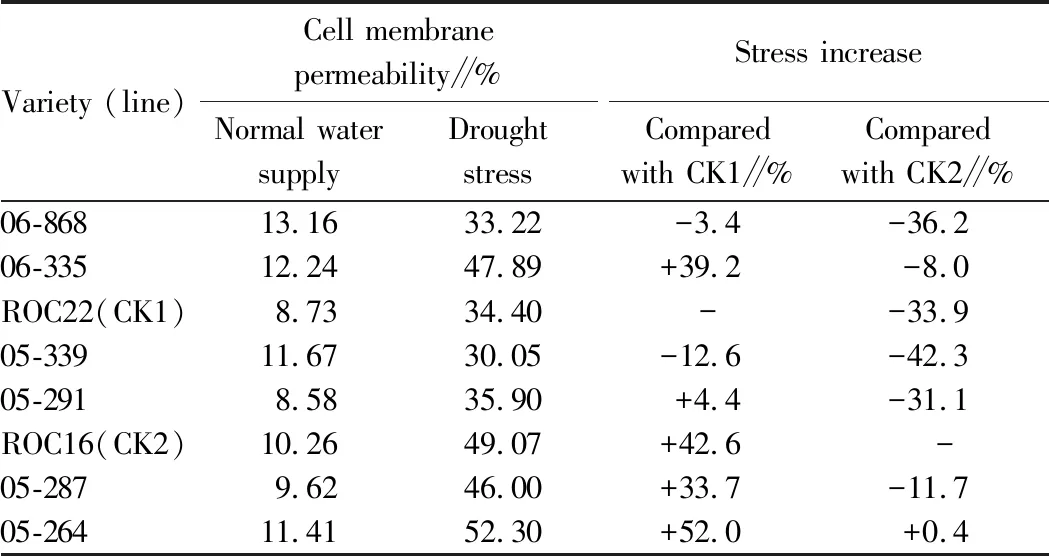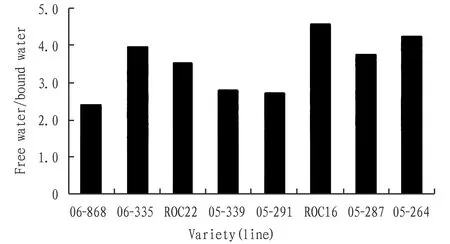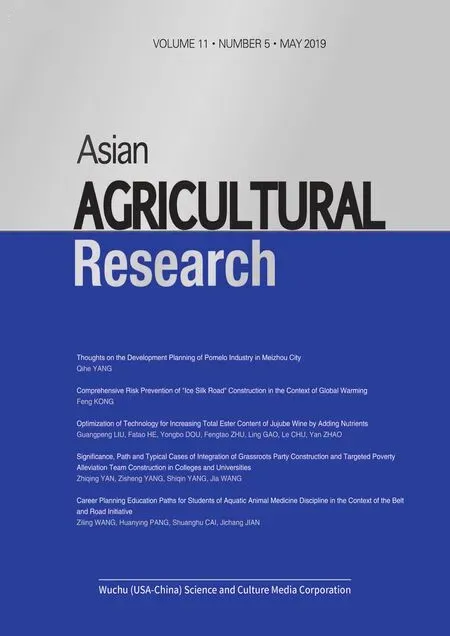Screening and Simple Identification of Drought-resistant Lines in Sugarcane Breeding
2019-06-27
Guangzhou Sugarcane Industry Research Institute/Guangdong Key Laboratory of Sugarcane Improvement and Biorefinery, Guangzhou 510316, China
Abstract Six sugarcane plant lines were selected from seedlings owing to good performance in agronomic characters under drought conditions. A special test with drought stress to death under groove was carried out to select the best drought tolerant clones among them. The proportion of bound water to free water content in leaves, cell cytoplasm membrane permeability in leaves, yield components, etc., which were regarded as reasonable indexes to identify drought resistance of sugarcane, were measured. The results showed that both YT06-868 and YT05-339 were winners. The two were high-class drought-resistant clones. On some measured indexes, both of them had higher values than ROC22 (the main check variety) and on the other ones, they both had the same values as ROC22. The drought resistance of YT05-291 was moderate and between ROC22 and ROC16 (the secondary check variety), while the others had poor drought-resistant according to these indexes.
Key words Sugarcane, Drought resistance, Drought stress, Identification
1 Introduction
With the development of economy in China, sugarcane is forced to be planted on dry slope land and remote hillside land without irrigation conditions because of the impact of grain, fruit, vegetable, flower, traditional Chinese medicine and other cash crops. The production of raw sugarcane in the main sugarcane producing areas of China is affected by drought to varying degrees. With the development of industry, the lack of drought-resistant varieties has made it unable to meet the current production needs of sugarcane areas, seriously restricting the healthy development of sugar industry. At present, it is not only costly, but also unrealistic to solve the problem of seasonal drought through the implementation of irrigation projects and other ways. Only through agricultural measures or breeding drought-resistant varieties can it be the most direct and effective measure to solve or reduce the problem of seasonal drought damage[1]. Based on the traditional breeding objectives of high yield and high sugar, it is an urgent task to strengthen the study of drought resistance of varieties[2].
Previous studies on drought resistance mechanism of sugarcane have been carried out at different levels[3-6]. There are also many reports on drought resistance identification[7-10], but some determination techniques are very complex. Some require sophisticated instruments and equipment, or the workload of analysis is too large to be suitable for large samples of testing. In the practice of sugarcane breeding, there are many different types of sugarcane lines, and it is obviously not realistic to identify the drought resistance of breeding materials by measuring many physiological indexes. In this experiment, the drought resistance of six excellent new sugarcane lines selected in advanced test nursery was preliminarily identified by a simple method of measuring drought resistance index. The purpose of this experiment was to screen out the strain materials with drought resistance characters. It lays a foundation for the successful breeding of new drought-resistant varieties and serves the regionalization and diversification of varieties.
2 Materials and methods
2.1 Test materialsThe sugarcane lines tested were Yuetang 05-264, 05-287, 05-291, 05-339, 06-335, 06-868; ROC22 with strong drought resistance was used as the main control (CK1) and ROC16 with weak drought resistance as the sub-control (CK2).
The soil of the test tank is undeveloped red soil taken from the forest farm of Guangdong Fengshou Sugar Industry Co., Ltd. The results of soil nutrient determination are as follows: pH 4.48, organic matter 1.64%, total nitrogen 1.11 g/kg, alkali-hydrolyzed nitrogen 37.25 mg/kg, available phosphorus 2.79 mg/kg, available potassium 31.77 mg/kg.
2.2 Test methodsThe tested materials were planted in the drought resistance test tank with drip irrigation equipment. The surrounding areas were isolated by concrete walls, and the water and nutrients between the grooves were not permeated, leaving a small hole with an aperture of 1 cm at the bottom of the grooves. The fill depth of cement tank (60 cm×40 cm×40 cm) was 45 cm (mixed with a small amount of river sand). Sugarcane was planted on 15 April 2010. Each variety (line) was planted in 12 grooves, including six grooves for normal water supply treatment and six grooves for drought stress treatment. There was one replication in every four grooves (two for normal water supply and two for drought stress treatment), with a total of three replications. Five robust single bud seedlings were planted in each groove. The final singling of seedlings was determined before tillering, and three main seedlings with the same growth were left in each groove. The tiller fertilizer was applied on May 20 and the stalk fertilizer was applied on July 5. The application of fertilizer and pesticide in each planting groove was the same, and the other management aspects were the same as those in the general pot planting.
The water management of each treatment was consistent before drought stress. Natural drought stress began on July 22. Under normal water supply treatment, uniform drip irrigation was carried out according to the law of sugarcane water demand. The intensity of drought treatment was to restore water supply to all treatments after permanent wilting of leaves of all strains (stress until August 2). After that, the water supply is the same as that under the normal drip irrigation treatment until harvest.
2.3 Measurement itemsThe membrane permeability (conductivity) of leaves of each treatment was measured by referring to theGuidanceofPlantPhysiologyExperimentedited by Zou Qi[11]. The ratio of free water to bound water was determined according to theprinciplesandtechniquesofPlantPhysiologyandBiochemistryExperimentedited by Li Hesheng[12]. The agronomic characters were measured according to the method defined in the Chinese Sugarcane Variety Chronicle[13]for the terminology of agronomic characters of sugarcane varieties. The yield was measured on January 10, and the effective stem number and sugarcane stem yield of each treatment (six grooves) were calculated. Finally, the loss rate of each variety (line) under drought stress treatment was calculated.
The loss rate of yield factors is calculated as follows:
The loss rate of an index (%)=(Drought stress value of the index-normal water supply value of the index)/Normal water supply value of the index×100.
Finally, according to Gao Jiyin’s Drought Resistance Grading and Evaluation Method, the drought resistance indexes of each variety (line) were comprehensively graded[14]. The drought resistance of each variety (line) was evaluated according to the general level.
3 Results and analysis
3.1 Cell membrane permeability of leavesCell membrane permeability is one of the main physiological and biochemical indexes to identify drought resistance of sugarcane varieties in China. There have been many reports on the determination of electrolyte leakage rate under plant water deficit by conductivity method to judge the degree of tissue injury and identify its drought resistance[15-16]. The permeability of protoplast membrane was sensitive to stress, and the increase of membrane permeability was observed under many stress conditions. The permeability of protoplast membrane reflected the stability of membrane under stress conditions. Under drought conditions, the increase of protoplast membrane permeability of varieties with strong drought resistance was significantly lower than that of varieties with weak drought resistance. For the same variety, when sugarcane plants were subjected to light drought stress, the damage of plasma membrane was small, and the electrolyte leakage value of plasma membrane increased little. The sensitivity of each variety (line) to drought stress was different, and the permeability of plasma membrane varied greatly (Table 1). Under normal water supply conditions, there was no significant difference in plasma membrane permeability among varieties (exosmosis rate 8.58%-13.16%). However, drought stress significantly caused membrane damage, plasma membrane permeability increased significantly, and there was a great difference in plasma membrane permeability among varieties. It can be seen from Table 1 that the plasma membrane permeability of Yuetang 05-264 is higher than that of the two control varieties. In terms of plasma membrane permeability, 06-335, 05-291, 05-287 were between the two control varieties. However, 06-868 and 05-339 were lower than the two control varieties. Therefore, from the point of view of cell membrane permeability alone, the drought resistance of Yuetang 06-868 and 05-339 lines was significantly better than that of the two control varieties.
Table 1 Cell membrane permeability of leaves in each treatment

Variety (line)Cell membranepermeability∥% Normal watersupply DroughtstressStress increaseComparedwith CK1∥%Comparedwith CK2∥%06-86813.1633.22-3.4-36.206-33512.2447.89+39.2-8.0ROC22(CK1)8.7334.40--33.905-33911.6730.05-12.6-42.305-2918.5835.90+4.4-31.1ROC16(CK2)10.2649.07+42.6 -05-2879.6246.00+33.7-11.705-26411.4152.30+52.0+0.4
3.2 Ratio of free water to bound water in leafThe content of bound water is directly related to drought resistance, if the content of bound water is high, the drought resistance is strong[17]. The content of free water and bound water is also closely related to the growth and resistance of plants. When the ratio of free water to bound water is high, the metabolism of plant tissues or organs is generally strong and they grow faster. On the contrary, it is slower, but the resistance is generally stronger. Therefore, the lower the ratio of free water to bound water, the stronger the drought resistance of sugarcane varieties[18]. It can be seen from Fig. 1 that the ratio of free water to bound water of the tested varieties (lines) is in the following order: ROC16>05-264>06-335>05-287>ROC22>05-339>05-291>06-868.From the point of view of this index, Yuetang 06-868 had the strongest drought resistance among the tested varieties (lines).

Fig.1 Ratio of free water to bound water of each treatment under drought stress
3.3 Effect of water treatment on yield of sugarcane
3.3.1Plant height. Plant height is one of the most important yield factors of sugarcane, which is very sensitive to water stress and is an ideal direct identification index. From Table 2, it can be seen that the plant height of each variety (line) under drought stress is smaller than that of normal water supply treatment. The damage rate of drought stress to plant height of each variety (line) was in the order as follows: Yuetang 05-287>05-291>06-868>05-339>ROC16>06-335>ROC22>05-264. The plant height loss of 05-287 and 05-291 was the largest, which was one of the biggest reasons for the loss of sugarcane stem yield.
3.3.2Stem diameter. Stress conditions not only inhibited the elongation of sugarcane stem, but also inhibited the transverse expansion of sugarcane stem tissue cells. It can be seen from Table 2 that the stem diameter of drought stress treatment is smaller than that of normal water supply treatment, and the loss rate of stem diameter is 2.37%-13.11%. The order of stem diameter loss of each variety (line) under drought stress was Yuetang 05-264>05-287>06-868>ROC22>06-335>05-291>05-339>ROCl6.
3.3.3Number of effective stems. The effect of drought stress on the effective stem number of each variety (line) was quite different. From Table 2, it can be seen that the effective stem number of Yuetang 05-291 under drought stress treatment is larger than that under normal water supply treatment. The effective stem number of Yuetang 06-868 and 05-287 was not affected, and the effective stem number of other varieties (lines) was smaller than that under the normal water supply treatment. The effective stem loss rate of Yuetang 06-335 was high, which was the main reason affecting its yield.
3.3.4Sugarcane stem yield. Sugarcane stem yield is the concentrated expression of various agronomic characters and the ultimate goal of sugarcane cultivation. The main purpose of drought resistance identification is to select varieties with stable and high yield under drought conditions. Therefore, the yield and yield reduction percentage of sugarcane under drought stress is an important index of drought resistance, which can much more directly reflect the economic performance of sugarcane varieties than morphological indexes and physiological indexes.
From Table 2, it can be seen that under drought stress, the yield of sugarcane decreased obviously, and the loss rate of yield decrease among varieties (lines) was obviously different. The order of yield loss rate of sugarcane under drought stress was as follows: Yuetang 05-287>06-264>06-335>05-291>06-868>ROC16>ROC22>05-339. From the analysis of the factors of sugarcane yield components, it is found that the main reason of sugarcane yield reduction caused by drought stress was that the main factors of sugarcane yield, such as effective stem number, plant height and stem diameter, were damaged to varying degrees, resulting in the decrease of single stem weight. However, the yield components of different varieties (lines) were different, and the main causes of yield reduction were also different. The loss of plant height of Yuetang 05-287 and 05-291 was the main reason for the loss of sugarcane stem yield. However, 06-335 drought stress resulted in dead stem, and the deficiency of effective stem was the main reason affecting its yield.
Table 2 Loss rate of sugarcane yield under water stress

Variety (line)Plant height∥cmNormalwater supply DroughtstressLossrate ∥%Stem diameter∥cmNormalwater supply DroughtstressLossrate ∥%Number of effective stemsNormalwater supply DroughtstressLossrate ∥%Sugarcane stem weight∥kgNormalwater supply DroughtstressLossrate ∥%06-868221.9198.0010.772.582.387.752323025.0020.4018.4006-335213.3199.506.472.872.667.32201810.0022.4017.1023.66ROC22268.3257.004.212.402.227.5023224.3524.2018.9021.9005-339239.7217.509.262.502.404.0023224.3522.9018.2020.5205-291243.8202.0017.152.322.186.032223-4.5519.1015.8017.28ROC16254.0233.508.072.532.472.37201810.0022.3016.7025.1105-287223.2181.0018.912.932.6011.261919024.2018.4023.9705-264222.1216.002.752.442.1213.1122214.5519.7014.3027.41
3.4 Comprehensive comparison of drought resistance of different varieties (lines)Drought resistance of crops refers to the ability of crops to survive and form yield under atmospheric or soil drought conditions, which involves the comprehensive ability of roots, stems and leaves of crops to absorb, transport, utilize and maintain water. The difference of drought resistance of different varieties reflected the different drought resistance ways (early resistance, drought avoidance) of different varieties and the different sensitivity to stress response. Under drought conditions, although there is the impact of other factors, under the same conditions, the response of physiological and ecological indexes related to drought resistance is mostly consistent with the drought resistance of sugarcane. The results of the comprehensive evaluation score are shown in Table 3. The results of drought resistance of sugarcane determined by the score are basically consistent with the cultivation performance of field experiment. According to Gao Jiyin’s Drought Resistance Grading and Evaluation Method, the drought resistance indexes of each variety (line) were comprehensively graded and divided into 4 levels according to the corresponding scores: strong (4), relatively strong (3), medium(2),and weak (1).The higher the score was, the stronger the drought resistance was. From Table 3, it can be seen that the drought resistance of Yuetang 06-868 and 05-339 is stronger than that of ROC22, and in terms of the drought resistance, Yuetang 05-291 is between the two control varieties.
Table 3 Evaluation of drought resistance indexes of tested varieties (lines)

Variety (line) Plasma membranepermeabilityFree water/boundwaterPlant heightStem diameterEffective stemnumberStem weightTotal levelDroughtresistance06-8684323444Strong06-3351233121WeakROC223443334Strong05-3394424334Strong05-2913313443Relatively strongROC161424112Medium05-2872112421Weak05-2641241311Weak
Note: The figures of each index in the table are the grade values of each single physiological index, which are divided by the relative values of the measured values. According to Gao Jiyin’s Drought Resistance Grading and Evaluation Method, it is divided into four levels. The total level is the sum of all index level values. The sum below 12 for level 1, level 2 (13-15), level 3 (16-19), and level 4 (20-24).
4 Conclusions and discussions
According to the comprehensive judgment of the results, the drought resistance index values of Yuetang 06-868 and 05-339 were higher than or close to those of the control varieties with strong drought resistance, and the yield loss rate was less than that of ROC22, so they could be selected as varieties with strong drought resistance for further observation test.
Yuetang 05-291 was between the two control varieties, the resistance was medium, and the drought resistance was above average. The drought resistance of other lines was relatively poor, and the comprehensive performance of resistance was the weakest, belonging to the type of non-drought resistance.
The drought resistance of sugarcane is composed of many factors, each of which is related to the essence of drought resistance. In the process of selection and breeding, it is not only demanding but also unrealistic to determine the complex physiological indexes and identify the drought resistance of many breeding materials. On the basis of previous studies, several simple, representative, sensitive and reproducible indexes were used for determination and identification, which will have certain practical significance to the early drought resistance identification of fine lines or breeding materials. The single index is closely related to the total level of drought resistance. The results showed that the lines with more than three physiological indexes of drought resistance at the same time could basically reflect the drought resistance potential of the varieties. The results were consistent on the whole, and were basically in line with the cultivation performance observed in field experiment. These simple and convenient identification methods will be helpful for breeding scientists to screen and identify drought-resistant varieties and reduce the workload of identifying the drought resistance of breeding materials.
This experiment used a relatively simple method for drought resistance index identification, the selected drought-resistant lines still need to be observed by advanced nursery test and comprehensively identified by a number of physiological and biochemical indexes. The actual drought resistance needs to be tested in a larger area of field production.
杂志排行
Asian Agricultural Research的其它文章
- Career Planning Education Paths for Students of Aquatic Animal Medicine Discipline in the Context of the Belt and Road Initiative: A Case Study of Construction Achievement of Guangdong Ocean University
- Effects of Different Herbicides on the Control of Malachium aquaticum L. and Poa annua L.
- Optimization of Technology for Increasing Total Ester Content of Jujube Wine by Adding Nutrients
- Comprehensive Risk Prevention of "Ice Silk Road" Construction in the Context of Global Warming
- Childcare, Elderly Caring and Off-farm Employment of Rural Couples in China
- Regional Advantages of Green Feed Production in China: Based on Panel Data of 31 Provinces in China from 2014 to 2016
